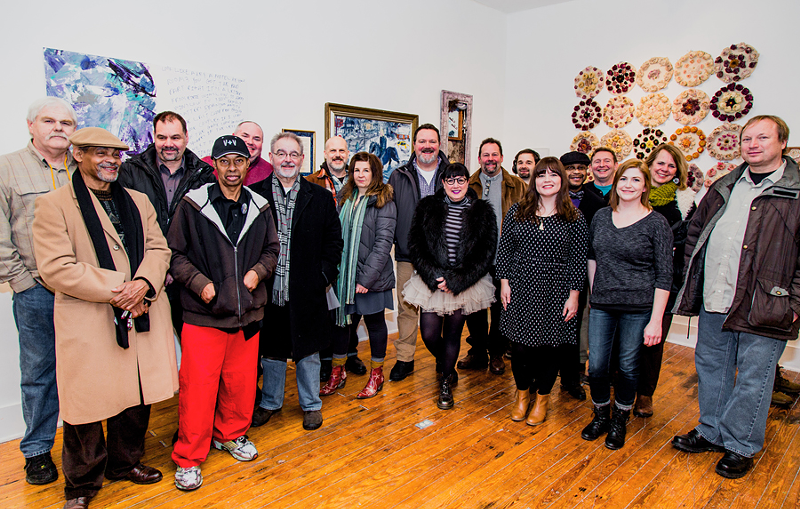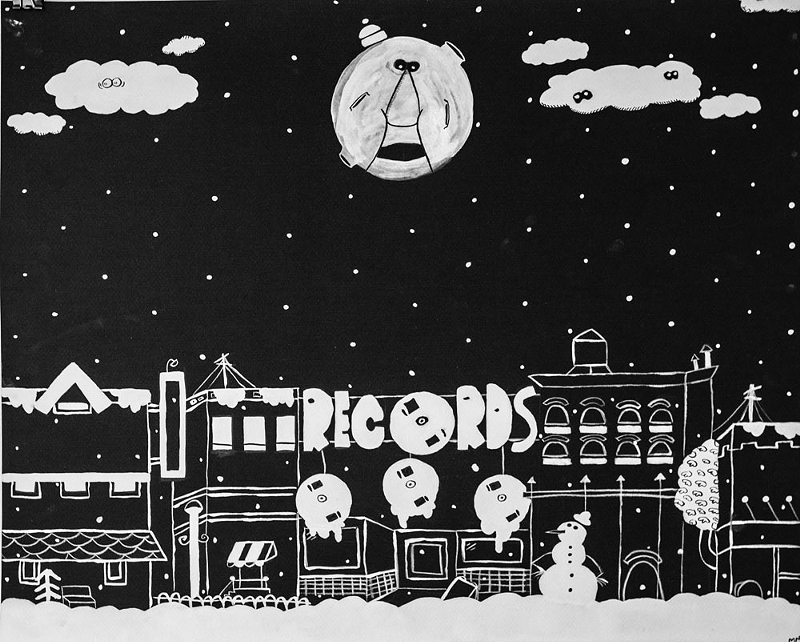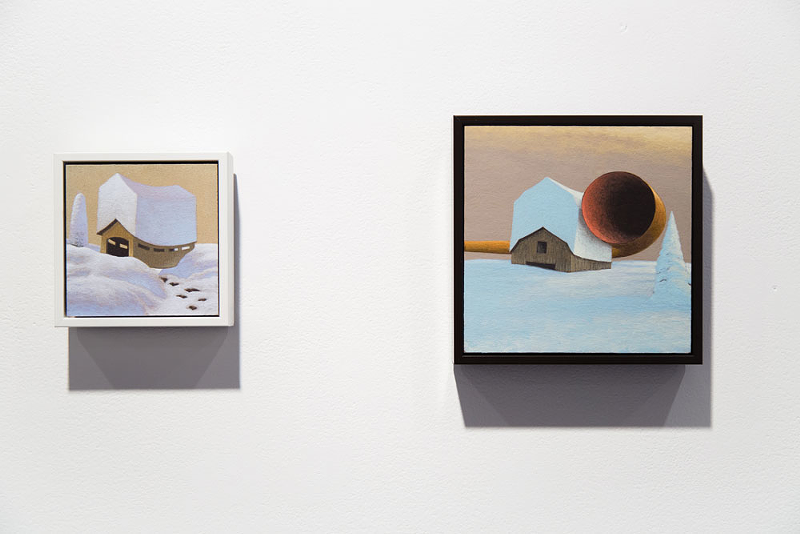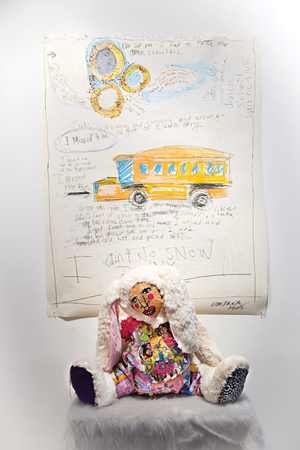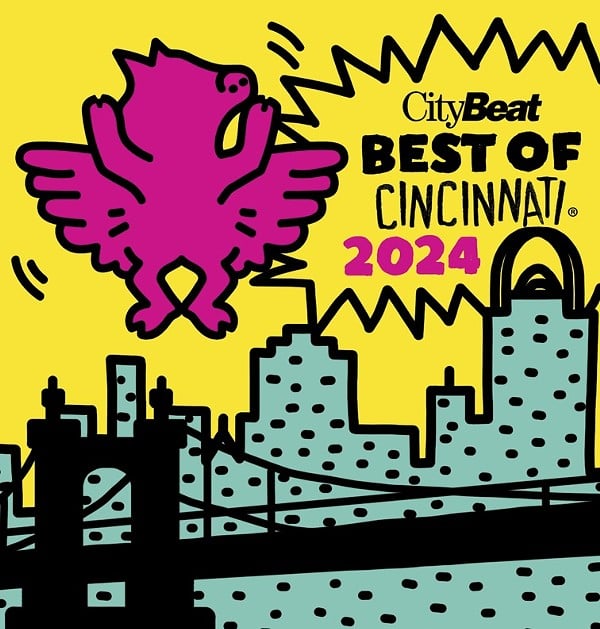It’s a simple enough explanation for the creative response to a simple-sounding show — Thunder-Snow: Artists Remember the Blizzard of 1978.
Yes, the Northside gallery’s exhibit includes some pretty paintings of winter wonderlands. But there’s much more that is unexpected. Banner’s observation — made the day after this past Christmas, when the temperature climbed to a record 71 degrees — hits on something as deep as the storm’s historic drifts.
A paralyzing blizzard is a community-builder and equalizer, and perhaps we need another one to blow through in these divisive and isolating times. Many of the exhibition’s 30 or so artists aren’t wishing for the heavy precipitation they remember from childhood so much as they are longing for the peacefulness and sense of purpose that came with it.
Banner and co-founder Bill Ross asked Thunder-Snow contributors — many of them friends from their days at Indianapolis’ Herron School of Art and Design — to include narratives with their artworks. They received sentimental memories of digging tunnels, sledding all day and curling up in quilts. But others responded with gut-wrenching accounts about death, abuse, poverty and not fitting in.
Thinking about a fresh blanket of white is like looking at one of the bulldozed sites drawn by the late outsider artist Raymond Thunder-Sky, a downtown icon and the gallery’s namesake. The “construction clown” was constantly tearing away the past and rebuilding a better future in his artworks. Likewise, snow is a clean slate for processing memories of a brutal and beautiful January nearly four decades ago, plus everything since then.
Some of the most powerful recollections in Thunder-Snow come from Ross, who initially doubted that blizzard stories could be the basis for a strong, diverse show.
A year ago, Ross wasn’t planning an exhibit but a dinner. He and Sharon Butler of O’Bryonville’s BonBonerie bakery/café were looking out on another mild January day and feeling wistful for the snowy winters of their youth. Butler suggested hosting a “memory dinner” centered on the inventive meals families made while housebound in 1978.
“Then it snowballed,” Banner says. He calls the show the little engine that could.
Banner’s press release describes Thunder-Snow as a multimedia exercise in aesthetic cabin fever. Butler’s celebratory dinner is taking place at the gallery on Jan. 27, and she has installed a kitchen bulletin board in the exhibit to solicit dish ideas. “You make food from what’s left. You make art from what’s left,” Banner says.
Ross masters that theme. In a stark four-piece series on wood, he turns to swaths of deep gray paint and black marker to pour out his memories of a childhood friend in a small Indiana town. The two quiet boys were mirror versions of each another. They looked alike, had gruff fathers and even had sisters with the same name, just spelled differently.
Then, late one afternoon during the long dig from the blizzard, that mirror shattered. Ross’ friend couldn’t be found. Ross was present when the body was discovered in a hayloft, a rope around his neck. His death was ruled an accident.
For awhile afterward, Ross’ dad treated his own family with more kindness. But then the snow melted and the cruelty returned. His dad shot one of the family dogs that following summer. In the final panel, Ross has painted a somber, snowy scene of footprints leading to a barn that’s since been leveled.
“January is not a good month for me,” Ross says. “You ask how you survive that, and you just do.”
The exhibit is a celebration of all stories of resilience, from the seemingly trivial to the outright tragic. There’s something pure here, Banner says, even if it’s sometimes a feeling rather than a fact.
The facts from the Blizzard of 1978 are mind-blowing. The storm struck the Ohio Valley and Great Lakes regions from Jan. 25-27, with up to 40 inches of snow in some areas. Gusts up to 100 mph created 20-foot drifts. Seventy deaths were blamed on the blizzard — 51 in Ohio.
In Cincinnati, 6.9 inches of snow fell during those three days, but it accumulated on top of at least 14 inches of existing snow. The blizzard came a year after another crippling winter in which the Ohio River froze for six days, then again for nine.
For all of January 1978, the city saw 31.5 inches of snow — the highest monthly total since recordkeeping began in 1870. On Jan. 26, the barometric pressure dropped to a record 28.81 inches — the type of reading associated with a hurricane. The wind chill that day reached 52 below zero.
Jesse Speight’s pencil drawings of people bracing themselves against that bitter cold are rendered with cheek-stinging realism. Today, he thinks about how hardship makes him feel grateful inside. “Most of us are coping with our own personal blizzards,” the Indianapolis artist writes, “but we can help each other dig out and move on.”
Ashley Couts, another Indiana artist, coped with the actual blizzard as a single mother in 1978, and she is using a flashback from it to work through a personal blizzard now. “I remember most the light glinting against the snow,” she says in an email interview. “It was a cold, white light that blurred everything and blotted out the sky.”
Couts intended to make a portrait from a family snapshot taken around that time. But while she worked on the piece this fall, her daughter died.
“I could no longer paint my frozen-in-time family,” she writes in her narrative for the show.
Instead, she submitted a swirling blue-white abstract that is at once calming and cataclysmic. “In the end, it seemed beautiful and that gave me hope,” Couts says. “That is the best we can ask for after a storm, I suppose.”
In addition to exploring personal blizzards, some contributors address the personal bubbles that keep us from reaching out and offering hope.
A “Thunder-Snow-Globe” from local artist Robert McFate sits front-and-center on a pedestal as a statement piece for the show. Created from a fast food container, it speaks to the make-do, can-do spirit of a survivor. But it also symbolizes the insular worlds in which we live — getting in our cars, driving to the takeout window, not interacting. “A globe’s purpose and full existence remains unrealized till shaken by another,” McFate says.
Steve Paddack’s small paintings subtly link the show’s extremes of hopelessness and humor. The first work is kind of a pun — a double-covered bridge. The rooftop layer of snow is taller than the structure itself. The second, titled “The Great Blizzard Listener,” shows a similar scene, but with what looks like an old-fashioned hearing tube wrapped around a barn.
The Indianapolis artist had completed the first painting and was working on the other when a friend passed away. He finished the second piece, but it didn’t “sit well” with him.
“It felt like I was mixing two metaphors kind of uncomfortably — this tall-tale humor of an exaggerated snowfall with this disquieting intrusion of something else,” he says. Paddack eventually realized he had to, in effect, listen to the silence of the snow and pause to accept the loss of his fun-loving friend.
Smiles come more easily when reading about the teenage tribulations of Cincinnati artists Jeff Casto and Pam Kravetz.
Casto’s country-themed collage of found objects is titled “ ’OLINE 78.” That’s short for the gasoline that ended up in his stomach when he got overzealous while siphoning fuel for a plow at his West Virginia childhood home. With no way to get to a hospital, his mom calmly told him to drink a lot of milk. “I was eventually well,” Casto writes in his narrative, “but must of burped gasoline well into late March.”
Kravetz dresses up a stuffed toy rabbit and declares she “ain’t no snow bunny” in a mashup of wintertime memories that include having to walk three miles in “1,000 feet of snow” because she missed the bus when classes dismissed early. Possibly worse than suffering frostbite through her gym shoes, Kravetz also missed out on the doughnuts that her older sister bought when she drove to school.
And that memory brings Thunder-Snow back to its food origins.
Sharon Butler’s installation includes meal-starter suggestions like Vienna sausages, maraschino cherries, pickles and Ragú — the kind of pantry items left after being snowbound for a week. The memory dinner she’s planning is an extension of the unsupervised, slightly dangerous winter fun that she recalls from her childhood in Finneytown and her resourcefulness as a young adult living in Clifton during the blizzard.In a phone interview, she recalls trudging to the IGA on Ludlow Avenue in the snow. “Everybody felt so good that they were out in this wonderful world where nothing was normal,” she says.
“The nostalgia for this necessity is kind of weird, but it really mattered,” Butler says. “It wasn’t scary — it was part of being alive.”
THUNDER-SNOW continues through Feb. 4 at Thunder-Sky, Inc., 4573 Hamilton Ave., Northside. Blizzard memory dinner 6-10 p.m. Jan. 27. Free. More info: raymondthundersky.org.
Blizzard Diary
BY KATHY SCHWARTZ
When the Blizzard of 1978 hit, I was about to turn 13 and living in New Bremen, Ohio, with my 82-year-old grandmother, Re.
New Bremen is some 100 miles north of Cincinnati, in Auglaize County. It’s a flat, rural community where residents scoff at the thought of an inch of snow closing school. The nearly 3,000 people living there represent the latest generations of hardy German stock.
Fast food restaurants now glow where farmhouses once stood on the edge of town. But the center of the 185-year-old village seems frozen in time. And my memories of that winter are well preserved, too. I started a diary in 1978. A budding journalist, I likely requested the journal for Christmas to record the transition to my teen years, which would arrive Feb. 2.
So as the blizzard took hold, I hunkered down in our Victorian home in town and, in a stream of consciousness, documented the really important things — such as not being able to watch television, see my crush or call my best friend, Debra, who lived on a farm about a mile away.
Edited for space, but not style, with annotations in italics:
Jan. 25 School delayed – then cancelled. When I called Deb to tell her, she said it’s getting bad out there. 9:30 A.M. – Snow + little fog.
Jan. 26 No School. A REAL BLIZZARD. TRIED TO GET DEB – LINES DOWN.
Jan. 27 No School. … A boring day. Ohio is a disaster area. Went to IGA by tobogan with Kendra, Jeff + Cherie (next-door neighbors). T.V. out. Found out Deenie (another neighbor, whose 68th birthday was that day) has gall bladder trouble. Can’t get to Hosp. Flip (her husband) doesn’t think she’ll live. (Frowny face.) Big drifts. Haven’t talked to Deb yet. But her dad called her aunt, + her aunt called us. He called from neighbors.
Jan. 28 Went to IGA. Took sled along. They had no bread. T.V. back – then out. Had drive cleaned. Boring day. Deenie better. … Haven’t rapped with Deb yet. Can watch Ch. 7 on T.V. tho’ (on my grandmother’s black-and-white set). Thank goodness.
(I’m sure Re and I had enough food on hand. But as the snow abated, I had a sense of adventure — not to mention cabin fever — and wanted to head the three or four blocks to the grocery nonetheless. I remember I bought flashlight batteries on that first trip. We didn’t need them, but I figured since I came all that way I should buy something.)
Jan. 29 New Bremen is a snow emergency area. Keep off roads. … Jan (a former neighbor whose son I had a crush on) said she’d come over and shovel. Re said no. I guess Re’s right, but I could have seen Kevin. … T.V. back. Watched Superstars (a sports show). Was outside a little while. B-R-R-R!!! … 8:30 p.m. – heard there isn’t any school tomorrow!
Jan. 30 No School. Talked to Debra. 1st she called from her grandma’s, then from her house. No School tomorrow! Debra didn’t have anything interesting to say. Well, what do you remember after 4 days? Sparky Anderson on Bob Braun Show.
Jan. 31 No school. Got 5 cards today. … 1st day of mail since blizzard. … Talked to Debra. I wonder if Kevin will come here on my birthday.
Feb. 1 Deb came over after school. (Yes, school resumed just before my birthday.)
Feb. 2 Happy birthday to me! … Kev came over. … Groundhog saw his shadow! 6 more wks of winter!
Editor’s note: The punctuation and style for these diary excerpts have been published as written in 1978. The ellipses denote skipping a portion of the diary passage.

